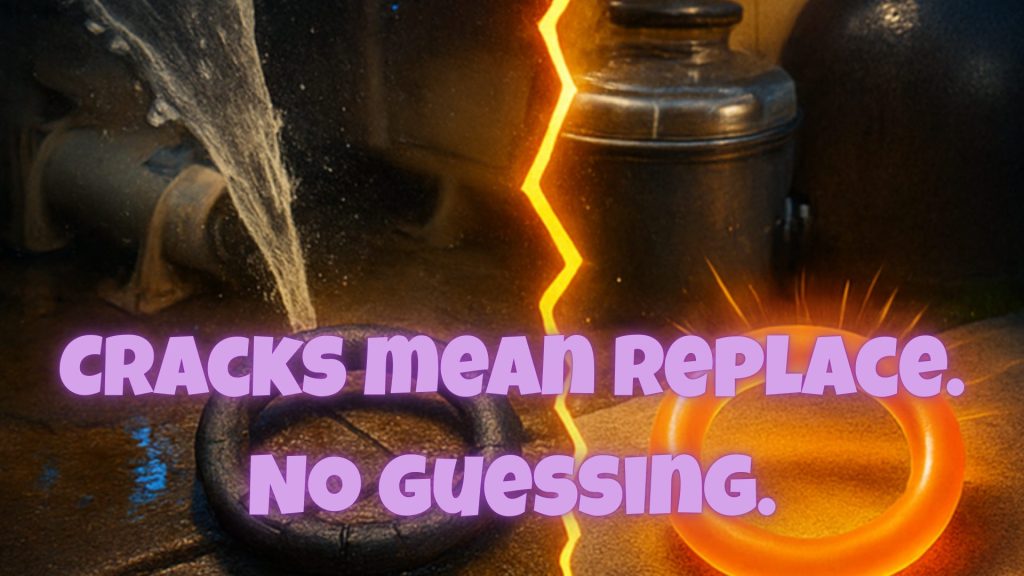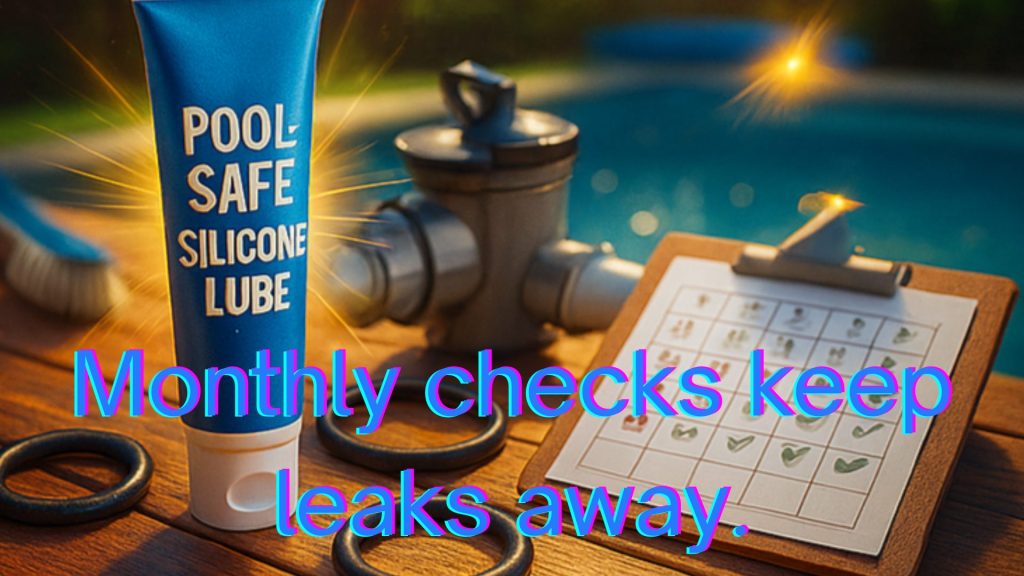Without regular pool o-ring maintenance, your pool’s o-rings dry out faster than sunscreen at a Fourth of July barbecue. One minute they are flexible and happy, the next they are cracked, crunchy, and plotting against your perfectly balanced backyard oasis. Keeping your o-rings lubricated as part of consistent pool o-ring maintenance is one of those small, often ignored tasks that can save you from big ugly problems down the line. Think of it like moisturizing your skin before it turns into a desert landscape. Except in this case, your skin is responsible for keeping water inside expensive equipment instead of all over your pool pad.
O-rings are the unsung heroes of the pool world. They sit quietly inside pumps, filters, chlorinators, and valves, sealing up the gaps and keeping your pool system tighter than a clam at a magic show. They do not ask for much. Just a little attention, a little lubrication, and a promise to follow proper pool o-ring maintenance. Just a little attention, a little lubrication, and a promise that you will not leave them to dry out like jerky hanging from a dashboard in August. When you forget them, they respond by cracking, leaking, and causing a flood that would make Noah take notes.

Lubricating your pool o-rings is not just about making them feel fancy. It is about extending their life, improving the seal, making your equipment easier to open and close, and preventing the tiny air leaks that can turn a well-tuned system into a sad gurgling mess. Think of it like brushing your teeth. It seems like a chore, but skipping it leads to way bigger problems than just a little bad breath.
The good news is that taking care of o-rings is simple once you know how and when to do it. Stick around and I will explain what these little rubber warriors actually do, how to choose the right lube that supports effective pool o-ring maintenance, and how often. Learn more about how o-ring lubrication helps preserve pressure stability and extend equipment life. Save yourself a fortune in repairs and keep your pool equipment happy and sealed tighter than a secret family recipe. Learn more about how o-ring lubrication helps preserve pressure stability and extend equipment life.
Even more importantly, properly lubricated o-rings reduce overall system strain by maintaining steady water flow and pressure balance. This means your pump works less to move water, your filter seals better to handle load cycles, and your chlorinator stays tightly contained, reducing wear and chemical loss. Smooth o-ring performance is directly tied to energy savings, fewer repairs, and longer life for every expensive piece of gear you depend on every summer.
Understanding What Pool O-Rings Do and Where to Find Them
O-rings are basically the pool equipment version of those rubber gaskets you find on pickle jars and fancy coffee tumblers. They are small but mighty, creating waterproof seals that keep high-pressure systems from exploding into sad fountains of wasted water. Every time you screw down your pump lid, filter tank, or salt cell, it is an o-ring standing guard inside that joint, holding back the floodgates with nothing but pure rubber determination.
You can find o-rings hiding in all the crucial spots. The pump lid has its own that needs to seal tightly to keep suction strong. Your cartridge or DE filter has a giant tank ring that keeps water pressure from blowing the thing apart like a kid overfilling a balloon. Chlorinators also have them to keep the nasty chemical soup safely contained. Multiport valves, check valves, and union fittings all have their own hardworking o-rings standing by silently doing their duty.

Without these, your system starts leaking faster than secrets at a family reunion. Pumps suck in air instead of water. Filters lose pressure and efficiency. Chlorinators drip precious sanitizer everywhere except where it is supposed to go. That is why a dry, cracked, or misplaced o-ring is not just a minor annoyance. It is a potential disaster waiting to happen every time you fire up your system.
Treat them like you would treat the tires on your car. You do not need to worship them, but you do need to check on them, maintain them, and replace them when they get too worn out to do their job. Otherwise, you are setting yourself up for a whole lot of wet regret and a repair bill big enough to fund a weekend getaway.
Regular o-ring inspection also helps catch hidden system leaks that can lead to bigger water loss issues. A slow drip from a neglected valve o-ring might not seem like much day to day, but over weeks it can add up to hundreds of gallons wasted and chemical balances thrown completely off. Learn how to track down hidden water loss and prevent pool leaks before they drain your wallet and your chlorine. Early detection and proper lubrication not only protect your equipment but also conserve water and keep your maintenance costs under control. Learn how to track down hidden water loss and prevent pool leaks before they drain your wallet and your chlorine.
Choosing the Right Pool Lube and What to Absolutely Avoid
Picking the right lube for your pool o-rings is not one of those decisions you can just wing like choosing a soda flavor. Using the wrong stuff is a fast track to disaster. Regular petroleum-based greases and household oils might seem like a quick fix, but they eat away at rubber faster than a hungry termite at a lumberyard. Petroleum melts and deforms o-rings until they crack, lose elasticity, and crumble into sadness.
The only lube you want anywhere near your pool o-rings is 100 percent pool-safe silicone lubricant. This stuff is specially designed to be waterproof, chemical-resistant, and gentle on rubber. It helps it stay flexible, improves sealing ability, and makes lids and valves easier to open without twisting them into oblivion. Silicone lube turns opening your pump lid from a wrestling match into a polite handshake. Learn how to maintain your pool equipment with smart habits and seasonal inspections to avoid lid strain, seal failure, and costly breakdowns. Learn how to maintain your pool equipment with smart habits and seasonal inspections to avoid lid strain, seal failure, and costly breakdowns.

Choosing the Right O-Ring Lubricant Is Essential
When shopping for pool lube, look for labels that specifically say pool safe or silicone-based. Avoid any multipurpose automotive greases, WD-40 sprays, or mystery pastes from the back shelf of your garage. One bad application can turn your perfectly healthy o-ring into a squishy mess faster than you can say pump failure.
Applying the lube is simple. Clean the o-ring with a little fresh water first to remove grit and debris. Dry it off completely. Then apply a thin, even coating of silicone lube using your fingers. You do not need to drown the thing. More is not better. A light even coat is enough to keep it slippery, flexible, and ready to protect your pool equipment like a seasoned bodyguard at a celebrity gala.
Choosing premium silicone lubes that resist chlorine breakdown extends protection even longer between maintenance checks. Some cheaper silicone products degrade faster under heavy chlorine exposure, reducing their effectiveness. Investing in high-quality pool-specific lube means stronger seals, easier equipment servicing, and greater reliability when your system needs it most.
How Often Pool O-Ring Maintenance Should be Done
Checking and lubricating your o-rings should be as regular as checking your skimmer basket for frogs and soggy leaves. Every three months is a good general rule, but more often if you are opening and closing pump lids, filters, or chlorinators a lot during heavy swim season. Any time you perform maintenance, backwash your filter, clean your cartridges, or service a valve, it is the perfect time to give your it a once-over.
Inspect them carefully for signs of cracking, flattening, brittleness, or noticeable wear. A healthy o-ring feels smooth, flexible, and a little springy. A dying o-ring feels dry, rough, and sad, like a pool noodle left out in the desert. If an it looks questionable, do not wait for a major leak to tell you it was time to replace it yesterday.

Applying a fresh coat of silicone lube during each inspection helps stretch the life of your o-rings and keeps your pool system tight, efficient, and leak-free. Preventative care beats emergency repairs every single time. Think of it like brushing your hair before a date instead of showing up looking like you wrestled a porcupine. A little effort goes a long way.
In peak season when your equipment is working overtime and temperatures soar, it is smart to increase your checks to monthly. Extreme heat, constant pressure changes, and heavy chlorine exposure all accelerate its wear. Staying ahead with regular maintenance keeps you in control, prevents downtime, and saves you a whole lot of stress when you would rather be cannonballing into your crystal-clear pool.
Keeping a simple maintenance log tracking o-ring inspections and lubrication dates makes it easy to stay ahead of problems. Quick notes on when each piece of equipment was checked ensures nothing slips through the cracks and builds a strong long-term habit of proactive pool equipment care that pays dividends season after season.
Why Pool O-Rings Maintenance Means Fewer Leaks, Longer Equipment Life, and Fewer Headaches
Lubricating your pool o-rings might seem like a small detail, but it plays a big role in keeping your equipment running like a dream. Healthy mean fewer air leaks, less wasted water, longer equipment life, and fewer surprise repairs when you least expect them. Your pool system stays tight, strong, and ready for action no matter how wild the summer parties get.
Taking five minutes to clean and lube an o-ring now saves you hours of headache later. Stay consistent, stay proactive, and treat it like the VIP gatekeepers they are. Your pool’s happiest when the seals do not squeak, the lids do not leak, and your backyard oasis keeps flowing smooth as a cannonball landing. Rooster Ray out and may your pool always stay sealed tighter than a vault full of pool party dreams.
Even better, well-maintained o-rings improve overall pool safety by preventing sudden equipment failures that could cause dangerous backpressure events or system blowouts. A small bit of care goes a long way toward keeping both your investment and your backyard crew safe while delivering perfect pool days every time you fire up the pump and jump in.
